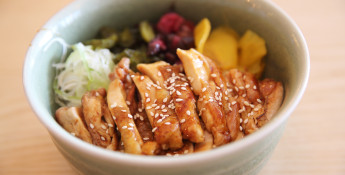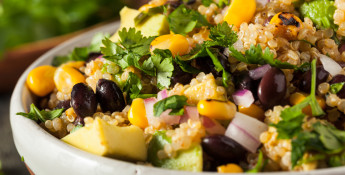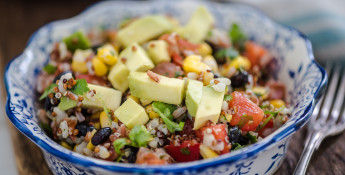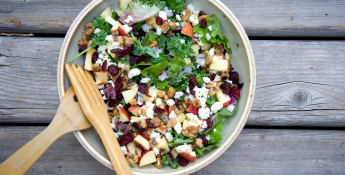By Karen Hanson on May 9, 2017
Power(ful) Bowls
Grab a bowl and make a healthful meal
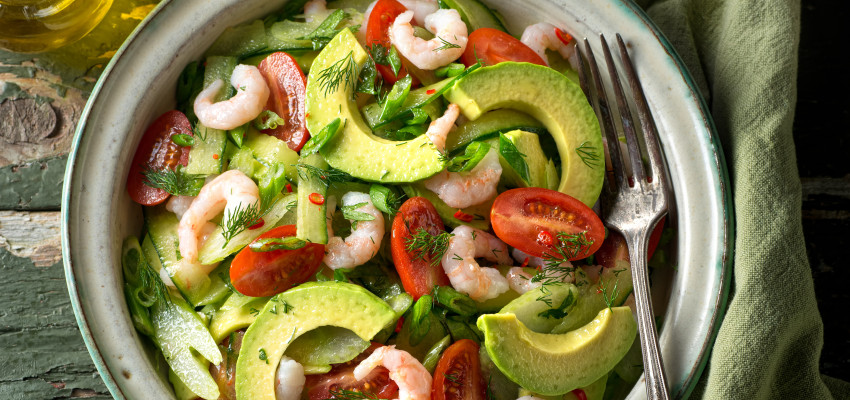
Although they won’t help you gain super-human strength or special powers such as invisibility, power bowls can help you get fit and stay fit — a feat within itself.
“You can place several of your favorite food items in a bowl and ta-da, you have yourself a great meal,” says dietitian Karen Hanson. “It’s easy, fast and, when done correctly, healthful.”
PERFECT PREP
Start by preparing ingredients for faster fridge-to-stomach time.
“Set up your power bowl by creating a salad bar of sorts in your fridge,” Hanson says. “Place baggies of prepped vegetables, fruits, beans and any other preferred toppings in a deep pan or tub and place in your fridge. This makes it so much easier than pulling each item from several places.”
PROTEIN PUNCH
Lean proteins such as fish, chicken breast, turkey, lean steak and eggs are good options to give you protein power. Canned salmon or tuna is also a quick go-to option.
“When I get home at night, I just throw the protein I’ve chosen on the grill or stovetop, then grab the toppings from the tub in my fridge,” Hanson says. “It’s so fast and simple.”
If you’re vegetarian or vegan, include frozen veggie burgers, tofu or quinoa.
GREAT GRAINS (AND LEGUMES)
Pre-cooking grains is another way to save yourself time in the kitchen.
“You can eat pre-cooked grains hot or cold,” Hanson points out.
She suggests quinoa, millet, oats, farro, sorghum, brown rice or a blend of your favorites. You can also include beans such as lentils, black beans, garbanzo beans, edamame or peas. Hanson suggests buying in bulk and cooking a big batch on the weekend, then dividing and freezing into portion-sized bags.
BUILD THE BOWL
When you’re ready to build your perfect power bowl, grab the produce you’ve prepped. And if you don’t have fresh veggies on hand, don’t fret.
“You can use frozen or canned vegetables, just be sure to prep them appropriately,” Hanson says. “Rinse canned vegetables to clear out some of the sodium.”
Add fresh strawberries, canned pineapple or dried cherries for a sweeter flavor in your bowl.
And if you want to try something a little different, roast vegetables like sweet potatoes, broccoli and cauliflower to add a great caramelized flavor.
FLASHY FLAVOR
After combining the protein, grains, beans, fruit and vegetables, keep the bowl lower-calorie by adding fresh herbs or a light dressing if necessary.
“Spice up the bowl by using fresh herbs like cilantro,” Hanson suggests. “Another great flavor profile to add to certain power bowls is a homemade peanut or almond butter sauce. Use it instead of a higher-calorie or sugary dressing to keep calories down, but maintain a rich flavor.”
TIP TOP
Finally, the toppings for your power bowl should not be overlooked.
“Nuts and seeds such as cashews, almonds and peanuts, flax and chia seeds add great crunch and are heart-healthy fats,” Hanson says. “Hummus is also a great way to add interesting flavor to your power bowl instead of loading up on a high-fat salad dressing.”
Consider goat cheese, feta, ricotta or your favorite shredded cheese as a topping. Other toppings include salsa, avocado, coconut oil, lemon juice or lime juice.
The possibilities are endless with power bowls. Just be sure to exercise portion control when filling up that mixture of flavors and ingredients.
“Keep things light and healthful by practicing smaller portions,” Hanson says. “Remember, a serving of grain is 1/3 to 1/2 of a cup. Protein should be kept to a three- or four-ounce serving. The best tip to offer with portion control is to use a normal-sized cereal bowl.”
Whether you want a seafood inspired bowl, a south-of-theborder bowl, a bowl with Thai flavor or a bowl that reminds you of Kansas City barbecue, power bowls are great meal options to consider when you want something quick and nutritious.
For the Asian Almond Butter Dressing and Power Bowl Recipes:

